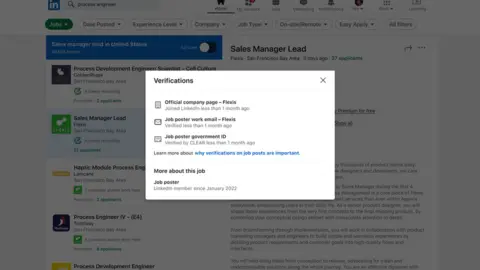Stopping the scammers who target online jobseekers
 Margo Gabriel
Margo Gabriel"Last week via LinkedIn, a person who presented himself as a recruiter for a UK-based company hiring content writers sent me a message," says writer Margo Gabriel.
"It piqued my interest, because the job would sponsor my relocation and work visa. He then said he would arrange an interview if I were interested - and I was."
But Ms Gabriel's suspicions were raised when she was told that the job would actually be based in Saudi Arabia rather than the UK, and the "recruiter" was cagey about details.
When she contacted LinkedIn, Ms Gabriel, who lives in Portugal, was advised to block him as a probable fraudster - and now believes she had a lucky escape.
With more than 100 job applications submitted per second on LinkedIn, scammers are increasingly targeting jobseekers with fake job opportunities. Indeed, according to research from security firm NordLayer, nearly two-thirds of British users have been targeted.
And the fake job ads aren't by any means restricted to LinkedIn, with scammers also exploiting other genuine, reputable job websites, as well as targeting university students directly by email.
The scams work in two main ways.
 fTeam
fTeam"You get a job offer with some basic information that sounds very interesting, and there is a link where they say that if I click, I'll see a presentation with details of the organisation and the job role," says Jedrzej Pyzik, a recruitment consultant at financial recruitment firm fTeam.
"Then, after clicking through the link, there's usually some kind of landing page where they require you to download something and log in and give personal details - this is the most common one I've come across."
That personal data can then be used to steal the jobseeker's identity, or even to open bank accounts or apply for credit in their name.
Another frequent scam is to ask "successful" job applicants to hand over money upfront, with a promise that they'll be paid back - commonly known as an advance fee scam. They may be told that this will cover training, Disclosure and Barring Service (DBS) checks into their criminal record, travel fees such as visas, or equipment needed for the job. However, if a cheque ever arrives to cover these costs, it bounces.
The problem of fake job ads is especially rife when it comes to students and new graduates, who may be seen as less savvy about the recruitment process. Indeed, according to security firm Proofpoint, a series of scams has been targeting US university students in recent months, mostly offering jobs in the fields of biosciences, healthcare, and biotechnology.
 Proofpoint
Proofpoint"Students may be more open to flexible and remote jobs that are conducted exclusively via the internet, and international students may not recognise telltale signs of fraudulent emails as well as native English speakers," suggests Selena Larson, Proofpoint senior threat intelligence analyst.
The messages which targeted the US students came from fake domains that mimicked genuine organisations, with the ultimate aim of persuading applicants to pay for computer equipment upfront, while supplying a fake cheque that would supposedly cover the cost.
One firm which has experience of its details being hijacked in this type of fraud is media buying agency MediaSpark, whose company information was used in a scam which targeted victims through popular job sites.
"I believe the objective is for job applicants to apply for the job so the scammers can capture their name, address, telephone number, email, et cetera," says chief executive Mathew Georghiou.
"I found out about it because some job applicants sent us their resumes directly, perhaps in addition to or instead of applying to the fake job posting on the jobs website."
 Matthew Georghiou
Matthew GeorghiouPlatforms are doing their best to eliminate job scams. LinkedIn says that 99.3% of detected spam and scams are caught by its automated defences, and that 99.6% of detected fake accounts are blocked before members even report them.
"Fake jobs or fraudulent activity are a clear violation of our policies and we're always working to stay ahead and keep our members safe," says a spokesperson.
"That includes using technology like AI, as well as teams of experts, to find and remove fake jobs and those that don't meet our jobs standards."
Late last year, LinkedIn introduced a series of new safety features. These include: "About this profile", which shows when a profile was created and last updated, along with whether the member has a verified a phone number or work email associated with their account.


New Tech Economy is a series exploring how technological innovation is set to shape the new emerging economic landscape.

Meanwhile, a a model based on deep learning, a technique that allows computers to learn by example, proactively checks profile photo uploads to determine if an image is AI-generated. It looks for subtle signs such as shared structural components - the area around the eyes and nose tends to be similar in such photos.
Users are also tipped off that something may be up when messages suggest taking the conversation to another platform.

Most significantly, the company is currently testing a feature that allows job posters to provide verified accounts and email addresses, so that job seekers know they're legitimate.
Job websites, too, are doing what they can. Keith Rosser, director of group risk at Reed, says the company carries out an automatic verification process to confirm the legitimacy of its advertisers, with checks against Companies House, company domain information, email accounts and physical and billing addresses.
He says: "As we look ahead, we are eagerly anticipating the protections that the Online Safety Bill will bring later this year. This new legislation is expected to strengthen our ability to combat job scams and provide even greater security for our valued users."
In the meantime, jobseekers are advised to be wary, check that the organisation actually exists and make sure that contact details are genuine before sharing any information.
